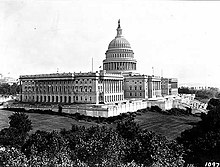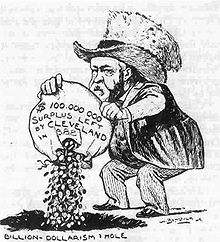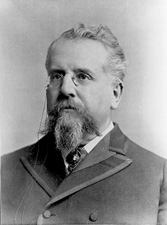51st United States Congress
| 51st United States Congress | |
|---|---|
50th ← → 52nd | |
 United States Capitol (1906) | |
March 4, 1889 – March 4, 1891 | |
| Members | 88 senators 332 representatives 9 non-voting delegates |
| Senate majority | Republican |
| Senate President | Levi P. Morton (R) |
| House majority | Republican |
| House Speaker | Thomas B. Reed (R) |
| Sessions | |
| Special: March 4, 1889 – April 2, 1889 1st: December 2, 1889 – October 1, 1890 2nd: December 1, 1890 – March 3, 1891 | |
The Fifty-first United States Congress, referred to by some critics as the Billion Dollar Congress, was a meeting of the legislative branch of the United States federal government, consisting of the United States Senate and the United States House of Representatives. It met in Washington, D.C., from March 4, 1889, to March 4, 1891, during the first two years of the administration of U.S. President Benjamin Harrison.
The apportionment of seats in this House of Representatives was based on the Tenth Census of the United States in 1880. Both chambers had a Republican majority. This marked the first time since the 43rd United States Congress that both chambers were controlled by the president's party.
Major events
- March 4, 1889: Benjamin Harrison became President of the United States
- December 29, 1890: Wounded Knee Massacre
Major legislation

It was responsible for a number of pieces of landmark legislation, many of which asserted the authority of the federal government.
Emboldened by their success in the elections of 1888, the Republicans enacted virtually their entire platform during their first 303-day session, including a measure that provided American Civil War veterans with generous pensions and expanded the list of eligible recipients to include noncombatants and the children of veterans. Grover Cleveland had vetoed a similar bill in 1887. It was criticized as the "Billion Dollar Congress'" for its lavish spending and, for this reason it incited drastic reversals in public support that led to Cleveland's reelection in 1892.
Other important legislation passed into law by the Congress included the McKinley tariff, authored by Representative, and future President, William McKinley; the Sherman Antitrust Act, which prohibited business combinations that restricted trade; and the Sherman Silver Purchase Act, which required the U.S. government to mint silver. The last two were concessions to Western farmer interests in exchange for support of the tariff and would become central tenets of the Populist Party later in the decade. They were authored by Senator John Sherman.
The Fifty-first Congress was also responsible for passing the Land Revision Act of 1891, which created the national forests. Harrison authorized America's first forest reserve in Yellowstone, Wyoming, the same year.
Other bills were discussed but failed to pass, including two significant pieces of legislation focused on ensuring African Americans the right to vote. Henry Cabot Lodge sponsored a so-called Lodge Bill that would have established federal supervision of Congressional elections so as to prevent the disfranchisement of southern blacks. Henry W. Blair sponsored the Blair Education Bill, which advocated the use of federal aid for education in order to frustrate southern whites employing literacy tests to prevent blacks from registering to vote.
- June 27, 1890: Dependent Pension Act
- July 2, 1890: Sherman Antitrust Act, ch. 647, 26 Stat. 209
- July 14, 1890: Sherman Silver Purchase Act, ch. 708, 26 Stat. 289
- August 30, 1890: Morrill Land-Grant Colleges Act
- October 1, 1890: McKinley Tariff, ch. 1244, 26 Stat. 567
- March 3, 1891: Forest Reserve Act of 1891
- March 3, 1891: Land Revision Act of 1891
- March 3, 1891: Immigration Act of 1891
- March 3, 1891: Merchant Marine Act of 1891
- March 3, 1891: International Copyright Act (The Chace Act)
States admitted and territories organized
- November 2, 1889: North Dakota and South Dakota were admitted as the 39th and 40th states.
- November 8, 1889: Montana was admitted as the 41st state.
- November 11, 1889: Washington was admitted as the 42nd state.
- May 2, 1890: Oklahoma Territory was organized.
- July 3, 1890: Idaho was admitted as the 43rd state.
- July 10, 1890: Wyoming was admitted as the 44th state.
Party summary
The count below identifies party affiliations at the beginning of this Congress. Changes resulting from subsequent replacements are shown below in the "Changes in membership" section.
Six new states were admitted during this Congress, and their Senators and Representatives were elected throughout the Congress.
Senate
| Party (shading shows control) |
Total | Vacant | |||
|---|---|---|---|---|---|
| Democratic (D) |
Republican (R) | Other |
|||
| End of previous congress | 37 | 38 | 1 | 76 | 0 |
| Begin | 37 | 39 | 0 | 76 | 0 |
| End | 35 | 51 | 86 | 2 | |
| Final voting share | 40.7% | 59.3% | 0.0% | ||
| Beginning of next congress | 39 | 47 | 2[a] | 88 | 0 |
House of Representatives
| Party (shading shows control) |
Total | Vacant | ||||
|---|---|---|---|---|---|---|
| Democratic (D) |
Socialist Labor (L) | Republican (R) | Other |
|||
| End of previous congress | 167 | 2 | 152 | 4[b] | 325 | 0 |
| Begin | 159 | 0 | 164 | 0 | 323 | 2 |
| End | 152 | 1 | 175 | 328 | 3 | |
| Final voting share | 46.3% | 0.3% | 53.4% | 0.0% | ||
| Beginning of next congress | 238 | 0 | 86 | 8[c] | 332 | 0 |
Leadership

Levi P. Morton
Senate
- President: Levi P. Morton (R)
- President pro tempore: John J. Ingalls (R), elected March 7, 1889
- Charles F. Manderson (R), elected March 2, 1891
House of Representatives
- Speaker: Thomas B. Reed (R)
Members
This list is arranged by chamber, then by state. Senators are listed in order of seniority, and Representatives are listed by district.
Senate
Senators were elected by the state legislatures every two years, with one-third beginning new six-year terms with each Congress. Preceding the names in the list below are Senate class numbers, which indicate the cycle of their election. In this Congress, Class 1 meant their term began in the last Congress, requiring reelection in 1892; Class 2 meant their term began in this Congress, requiring reelection in 1894; and Class 3 meant their term ended in this Congress, requiring reelection in 1890.
|
|
 
|
House of Representatives
The names of members of the House of Representatives are preceded by their district numbers.
Changes in membership
The count below reflects changes from the beginning of the first session of this Congress.
Senate
- Replacements: 3
- Democratic: no net change
- Republican: no net change
- Liberal Republican: 1-seat net loss
- Deaths: 3
- Resignations: 2
- Interim appointments: 1
- Seats of newly admitted states: 12
- Total seats with changes: 17
House of Representatives
- Replacements: 16
- Democratic: 2-seat net gain
- Republican: 2-seat net loss
- Deaths: 11
- Resignations: 6
- Contested election:8
- Seats of newly admitted states: 7
- Total seats with changes: 33
Employees
Senate
- Chaplain: John G. Butler (Lutheran)
- Secretary: Anson G. McCook
- Sergeant at Arms: William P. Canady, until June 30, 1890
- Edward K. Valentine, from June 30, 1890
House of Representatives
- Chaplain: William H. Milburn (Methodist)
- Clerk: Edward McPherson
- Doorkeeper: Charles E. Adams
- Postmaster: James L. Wheat, resigned October 1, 1890
- Clerk at the Speaker’s Table: Nathaniel T. Crutchfield
- Sergeant at Arms: Adoniram J. Holmes
See also
- United States elections, 1888 (elections leading to this Congress)
- United States elections, 1890 (elections during this Congress, leading to the next Congress)
References
- Martis, Kenneth C. (1989). The Historical Atlas of Political Parties in the United States Congress. New York: Macmillan Publishing Company.
{{cite book}}: Cite has empty unknown parameter:|coauthors=(help) - Martis, Kenneth C. (1982). The Historical Atlas of United States Congressional Districts. New York: Macmillan Publishing Company.
{{cite book}}: Cite has empty unknown parameter:|coauthors=(help)
External links
- Biographical Directory of the U.S. Congress
- U.S. House of Representatives: House History
- U.S. Senate: Statistics and Lists
- Official Congressional Directory for the 51st Congress, 1st Session.
- Official Congressional Directory for the 51st Congress, 2nd Session.
Cite error: There are <ref group=lower-alpha> tags or {{efn}} templates on this page, but the references will not show without a {{reflist|group=lower-alpha}} template or {{notelist}} template (see the help page).


